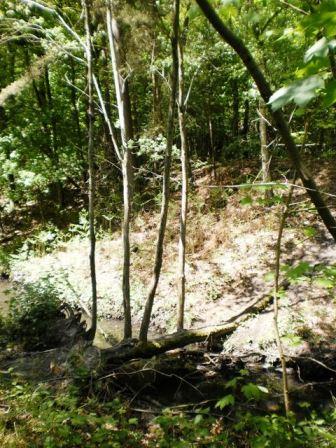An easy way to bridge a gap or river is felling a tree on the bank and dropping it to the other side. Some branches may serve as guidance. Two or three logs side by side, with between them a filling of stone and /or ground make the bridge wider. And a handrail or railing makes it safer.
In case of large spans reinforced constructions are needed. For example oblique supporting poles on the banks. Or piles in the water. Wood does not rot as quickly underwater. However, on the transition between wet and dry.
The degradation rate for wood is
under water ≈ 0 to 1 mm / year
in dry state ≈ 2 to 10 mm / year
with strong dry period ≈ 100 mm / year.
Therefore, for stilt houses, dams, floodgates wood of durability class 1 is used.
Class 1: lignum vitae, azobé (widely used in bridges), class 2: yew, chestnut, locust, 3: nuts, 4 apple, spruce, oak (ships), elm). Oak, pine and spruce are most commonly used as piles.
Stone constructions are also useful in this regard.
Cement products (mortar and concrete) don’t become hard as clay by drying, but by a chemical reaction (which needs water), even under water! This is how it is also tested in the lab. Cement is a hydraulic binder, it hardens under water even more quickly. Once cured concrete or mortar no longer dissolves back into water. (Special underwater concrete gets an addition to make it syrupy so that the mass stays together under water.)
Opportunities to strengthen the bridge are fitting arcs or parallel bridges under or above the deck, and both connected.
There may also be pylons with a heavy foundation set up which cables on both sides run to the bridge (a suspension bridge) or starting from a point and fanning, either separately from point to point (harp shape).
Just like a string can any cable vibrate at a certain frequency. This is called the natural frequency of the tether. To counter this vibrating dampers are used.
Not only tethers have their own frequency, also bridges: the vibration time. Soldiers do not march on a bridge, the group steps out of line to avoid synchronization! If the time between steps is the same as the vibration period of the bridge, the bridge vibrates and can be damaged.
Some special types: drawbridge, suspension bridge, pontoon bridge, swing bridge...
Living bridges
 In the East Khasi Hills district of India are living bridges cultivated in very rainy area Cherrapunji (Meghalaya), also called root bridges. Aerial roots of Indian rubber tree (Ficus elastica) are intertwined by residents with parts of a betel palm (Areca catechu) and led to grow to the other side of a river as a bridge. With earth and stones, a pavement is made . The roots, and thus also the bridges are stronger by the years. Making a living bridge takes ten to fifteen years. Some living bridges are centuries old, up to 500 years. The longest bridge measures thirty meter.
In the East Khasi Hills district of India are living bridges cultivated in very rainy area Cherrapunji (Meghalaya), also called root bridges. Aerial roots of Indian rubber tree (Ficus elastica) are intertwined by residents with parts of a betel palm (Areca catechu) and led to grow to the other side of a river as a bridge. With earth and stones, a pavement is made . The roots, and thus also the bridges are stronger by the years. Making a living bridge takes ten to fifteen years. Some living bridges are centuries old, up to 500 years. The longest bridge measures thirty meter.
In Japanese Iya Valley (Tokushima prefecture) bridges are made of living vines. Wisteria floribunda is planted on both sides of a river. The vines are woven together into a bridge, the walkway is made of planks.
